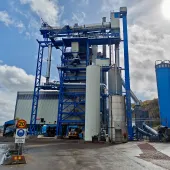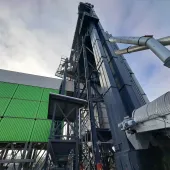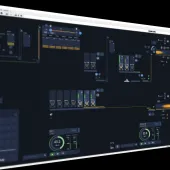Moisture in Asphalt Production
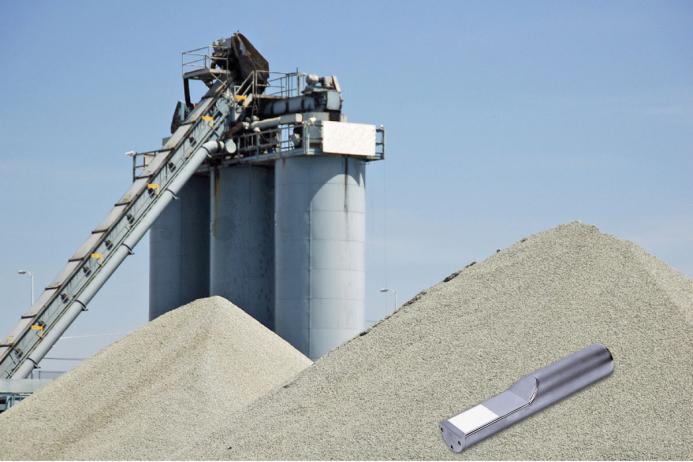
First published in the January 2023 issue of Quarry Management
Hydronix, specialists in microwave moisture measurement, outline how accurate moisture measurement and control can reduce costs and ensure consistent quality in asphalt production
The increasing cost of raw materials and energy is making asphalt producers look at their production process in much greater detail than in the past, so when a panel of industry quality-control experts was asked what automated measurements would add value to asphalt production, ‘moisture content on belts/in bins’ and ‘automatic gradation and moisture measurement from belt sampling’ were among the top-three replies.
Proven in-line technologies are now available that can provide a very real economic benefit and allow greater process control, reducing costly on-site testing and off-line forms of control. The necessity for more exact process control is further reinforced by moves towards more plant/process certification. Instrumentation has become a major part in allowing asphalt producers to differentiate themselves from others through repeatable quality, reliability, and efficiency. This differentiation and ‘getting it right first time’ can be the difference between winning a job and losing an important customer.
Sources of variation in moisture and their effects
Moisture contents can change in aggregates stored in cold-feed bins, in the RAP (if used), and in finished hot- or warm-mix asphalt (HMA and WMA). By measuring moisture in the incoming materials, the finished asphalt product can have its moisture level controlled in a proactive, real-time manner.
A change in the moisture content of the raw materials due to rainfall or dry weather will have a very large impact in the grading of the aggregates being loaded into the dryer and, therefore, on the quality of the asphalt produced. It also changes the energy consumption of the dryer quite considerably and can result in under-yielding.
In practice, fine aggregates can hold considerably more moisture than coarser gravels, and therefore it has been found that the greatest benefit from moisture measurement is usually achieved in aggregates with particle sizes less than 10mm. Field trials have proven that by using Hydronix microwave moisture sensors, measurement accuracies of ± 0.2% can be achieved, exceeding the industry requirement.

Batch plant operations
Precise control may be achieved with a sensor measuring the fine material, which is the most susceptible to moisture variation (see A1). Although not often required, more precise control may be achieved by measuring the coarse materials (B1).
The most popular and simple method is to install a single sensor (at position A2) to measure the blended material. This is used to manually or automatically adjust the feed rate of the fine material to ensure that the hot bins are filled evenly. Other benefits include:
Inconsistent feeding of aggregates from the cold bin can lead to some hot bins overfilling while others remain low on materials
Moisture variations can cause the dryer to work inefficiently, resulting in over-drying already dry aggregate or the output of insufficiently dry material
Moisture variations can lead to aggregates leaving the dryer and entering the hot storage bins at different temperatures. This can lead to variations in the hot storage bins that requires correcting
By adjusting the dryer rate taking into account the moisture content of aggregate feed, energy savings can be made.

Continuous (drum) plant operations
In the production of asphalt by drum mixing, aggregate gradation is controlled at the cold feed and therefore ensuring the accuracy of the cold feed is essential. Installing Hydronix Hydro-Probe moisture sensors at the belt weighers or at the base of the cold-feed bins allows real-time feed adjustment, ensuring that the correct dry weight of aggregates is loaded into the drum mixer, resulting in:
Increased yield and reduced asphalt binder usage through correct aggregate gradation
The burner rate can be adjusted to suit the moisture content of incoming materials, allowing efficiency monitoring
Energy savings (see return on investment)
Control of final HMA moisture content
Reduction in inadequate adhesion between asphalt binder and aggregates.

Warm asphalt operations – low-energy asphalt and foamed asphalts
Warm asphalt production techniques require a higher degree of accuracy in aggregate gradation to ensure asphalt quality comparable with HMAs. The role of water is essential to achieve the desired ‘foaming’ effect when mixed with the bitumen, allowing the system to uniformly coat all the aggregates.
Hydronix equipment allows real-time and on-line moisture measurement of the aggregates before they are fed into the pugmill, mixer, or drum. With a feed-forward automation system, producers can correct aggregate weights in real time. For techniques that use the water in the aggregates themselves for the foaming effect, information about the quantity of water being fed into the mixer or pugmill can also be known.
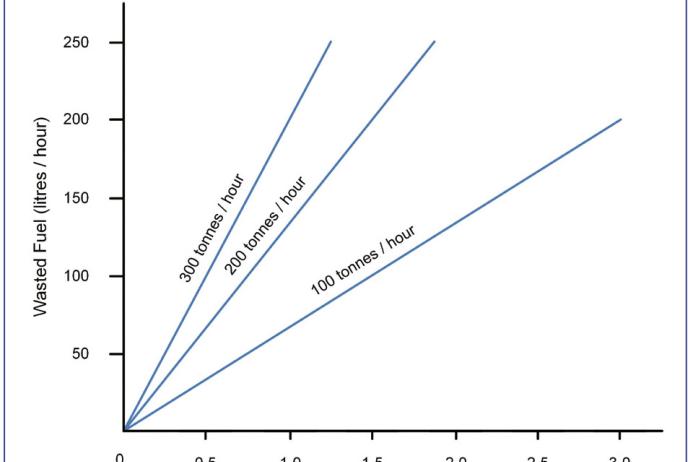
Return on investment
It has been found that a 1% increase in moisture in one tonne of aggregate can result in an additional 0.6 litres of fuel being consumed to evaporate it. At 6% moisture, 4 litres of fuel are required to dry 1 tonne of aggregate. Once dry, 3 litres of fuel are required to heat the aggregate to 150°C, meaning that more energy is used in drying the aggregate than in heating it.
In practice, the dryer or drum’s exhaust temperatures is already measured and used for feeding back information into the burner control. Online moisture measurement, however, allows real-time dryer/drum adjustments relating to the material inside, not the material already discharged. This reduces the process control time lag and ensures that the correct dry weights are being loaded into the dryer, resulting in savings and quality improvement.
If a plant runs 300 tonnes of asphalt per hour at 6% moisture, it will be using 1,200 litres per hour of fuel to dry the aggregate before it is heated up to the correct temperature. If the moisture content then changed from 6% to 5%, without the dryers being adjusted for an hour, that would equate to 180 litres of fuel being wasted in that one hour. Were this to be the case, Hydronix moisture measurement equipment would pay for itself in approximately 30 production hours. A reduced process control time lag continuously improves the efficiency of the plant. In most cases, Hydronix moisture measurement systems will pay back within the first three to six months in operation.
Moisture measurement can also be used to evaluate the dryer’s performance. Should the exhaust temperatures and incoming moistures not match (exhaust temperature increases with reducing moisture contents and vice versa), there may be a requirement to tune the dryer.
There are other economic effects of moisture measurement. By knowing the correct moisture content in the aggregates, it is possible to maximize the efficiency of the drying process to reduce over drying and wasted production time, thereby increasing the yield of the plant. Customers using automated moisture measurement consistently report improved output rates.
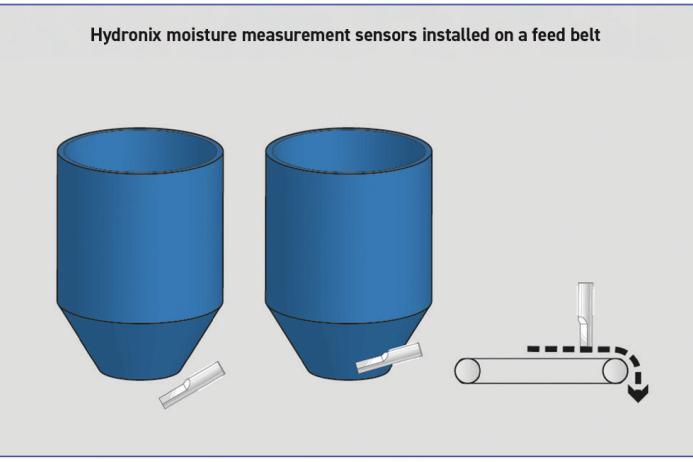
Installation and commissioning of a moisture sensor
The wide range of digital moisture measurement sensors supplied by Hydronix can be used for installations in the base of the cold-feed bins, on the feed belts, or alternatively on a loading ‘plate’, as used by CETE (Centre D’Études Techniques de l’Équipement) in testing. In practice, the first two positions are generally the easiest installation locations.
Hydronix sensors take 25 readings per second, allowing them to measure changes in moisture immediately. Integration with the customer’s control system is simple, via the use of standard analogue outputs. Full communication with the control system is also available via digital comms (RS485/RS232) and the latest asphalt plants are now using Hydronix Ethernet Adapters for communication with sensors.
Calibration consists of finding the linear correlation between the sensor’s ‘unscaled’ reading (always 0 in air and 100 in water, allowing easy sensor swap-out if required) and the moisture content in a particular aggregate. This is done by simply running material past the sensor’s face and taking a reading of the sensor’s unscaled value. A sample of the material is taken and then oven dried to find its moisture content as per the applicable standard. Once the above procedure has been carried out for a few points over the moisture range of the aggregate, the sensor will accurately read moisture – online and in real time.
It pays to invest in moisture control
Moisture is clearly not the only issue the asphalt producer has to contend with to ensure quality control requirements are met within tight economical constraints. However, it is a simple improvement that brings immediate, quantifiable returns. Accurate moisture measurement and control is now well established and proven to directly reduce costs, as well as ensuring consistent quality product and improving competitiveness.
- Subscribe to Quarry Management, the monthly journal for the mineral products industry, to read articles before they appear on Agg-Net.com


